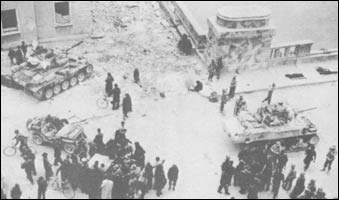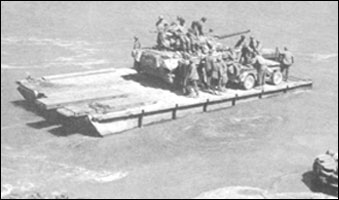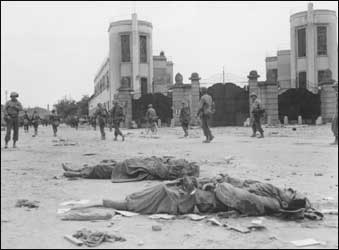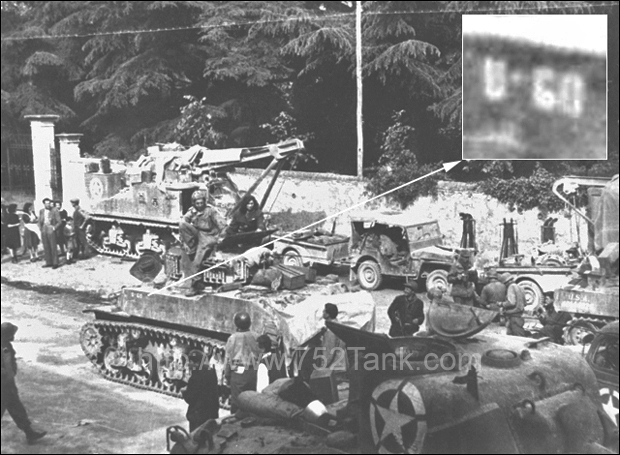D Company Helps Take Verona
 |
| An M24 and M5A1 light tank of an unknown armored unit at Ponte della Vittoria bridge the morning after the battle. Photo taken shortly after the 752nd had pulled out. |
- Researched and Written by Robert J. Holt -
By the time the 752nd
Tank Battalion entered combat, its M5A1 Stuart
light tanks were already considered vastly inferior to German tanks,
both in terms of firepower and armored protection. Though seriously
outclassed as a fighting vehicle, the M5A1 did provide great speed,
endurance, and agility. As a result, the 752nd generally did not deploy
its seventeen M5A1 tanks in combat roles, but instead used them for
armored reconnaissance, where mobility was crucial. During the last
week of the war in Italy, a unique and unanticipated situation forced
these light tanks to spearhead the rapid advance north of the Po River
toward Verona. What follows is a remarkable story of the courage and
determination demonstrated by the light tankers in that action.
The city of Verona, home of Shakespeare's Romeo and Juliet,
was strategically important to the Germans. In addition to being a key
rail and communications center, the convergence of several major
highways made Verona the hub of several escape routes to the Alps at
the foot of the Brenner Pass. From a defensive point of view, Verona
was an ideal city. It contained a belt of city walls, fortifications,
and ditches dating back to both ancient Roman and medieval times. Thick
palace walls and numerous towers cast dark shadows across the narrow
streets.
The Allied commanders clearly recognized how important it was
to prevent significant numbers of Germans from passing through Verona.
However, the Germans had blown all of the bridges across the Po,
delaying the 5th Army forces in their pursuit. As a result, the heavy
equipment of the 5th Army was forced to wait on the south bank of the
Po River while the engineers built pontoon treadway bridges for the
crossing of tanks, tank destroyers, and artillery pieces.
While the tanks of the 752nd waited for a pontoon bridge to be
completed in the Revere - Ostiglia sector, a river barge was discovered
in the area and pressed into service. Beginning around 1600 hours on 25
April, five M5A1 tanks of the 752nd's D Company and seven tank
destroyers of B Company of the 805th Tank Destroyer Battalion were
individually ferried across the Po on this barge. The barge struggled
to stay afloat under the weight of the tanks, and it was determined
that the Shermans of the 752nd would be too heavy to cross in that
manner. As a result, these M5A1 Stuarts and M18 Hellcats were the only
Allied armor in that sector to cross the Po River before the pontoon
bridge at Revere - Ostiglia could be completed. The bridge was not
operational until the early morning hours of the following day, leaving
the light tanks to spearhead the advance north of the Po River.
 |
| An M18 and jeep of the 805th TD battalion crossing the Po River on a barge at Revere, 25 April 1945. M5A1 light tanks of the 752nd had already crossed. |
Clearly,
the plans had called for a much larger number of armored vehicles to
make the advance on Verona, but time and speed were of the essence.
Upon crossing the Po, the light tankers received orders to proceed
north to Verona with all possible speed. The small contingent of M5A1
light tanks and M18 Hellcats raced up Highway 12 to join F Company of
the 88th Infantry's 351st Regiment. The infantry company had been
ferried across the Po the previous day in LVT-4 Amtrac amphibious
vehicles operated by tank drivers of the 752nd. As the forces linked
north of the Po, the infantry mounted the tanks, and the tank-infantry
team sped once again toward Verona.
As they moved toward Verona, the force split into two columns.
One column moved up the well-paved Highway 12, and the other moved
along a roughly parallel road about 3,000 meters to the east. The force
on the smaller parallel road was preceded by an advance guard moving
well ahead of its main column. A single M5A1 light tank of the 752nd
supported this advance guard.
Only light resistance was met for the first eleven miles, and
then a sharp firefight erupted when the advance guard reached the town
of Nogara. Here, a German force of approximately three hundred troops
of the 1st and 4th Parachute Divisions had set up a delaying action
with the support of two 20mm guns, several machine gun nests, and a
57mm gun concealed in a fortified mill. Fire from the enemy positions
was heavy, and the German 57mm gun succeeded in destroying an armored
car of the 88th Reconnaissance Troop. The German guns were eventually
silenced, and the American advance guard moved on.
During the next two hours, the lone Stuart at the head of the
advance fought in four separate engagements. As the advance guard
pressed on, this single M5A1 tank destroyed eight 20mm guns and
numerous machine gun nests. Because the advance guard was so far ahead,
the main column was not delayed by the action. Around 1800 hours, the
remaining four M5A1s and seven M18 tank destroyers joined the lone
Stuart. Three more brief engagements were fought in the fifteen miles
between Nogara and Ca di David as the forces moved rapidly onward. The
last engagement at Ca di David was only four miles from the heart of
Verona.
At approximately 2000 hours, the tank-infantry column crashed
through the city limits of Verona, becoming the first American troops
to enter that city. The force moved cautiously through the city until
2210 hours. At this point, mounting enemy resistance and considerable
debris at the heavily bombed railroad yards stopped the advance. At the
railroad yards, broken and twisted rails lay scattered in all
directions. The few passenger and freight cars that were not completely
shattered hung precariously from the partially destroyed railroad
bridge. After a brief firefight in this vicinity, the light tanks
advanced completely through the city and took up entrenched positions
at several critical road junctions.
The M5A1 tanks of the 752nd had moved at an incredibly rapid
pace that day. Though involved in several firefights, they had covered
a distance of approximately thirty miles (forty-eight kilometers) from
the Po River to the heart of Verona in slightly more than six hours. So
rapid was their advance that a huge number of Germans were bypassed in
the process. These bypassed Germans continued to flee northward toward
Verona along Highway 12 during the remainder of the day and throughout
the night, unaware that they were following the same route the American
troops had previously taken.
All through the night, the enemy funneled into the city limits
from the side roads to the southeast and southwest in an attempt to
rally inside the city. The appearance of the American tanks and
infantry in Verona was so unexpected by the Germans that many of their
units simply rushed headlong into the roadblocks set up by the M5A1s
and M18s. Despite heavy fire, the American tankers successfully blocked
every attempt the Germans made to pass through the road junctions that
were so important to their escape. As Dog Company veteran Walter Lupkes
describes it, his tank took cover behind buildings at critical road
junctions, and all through the night they would pop out from cover,
fire several rounds, and then duck back into cover. This tactic was
employed over and over again with each successive enemy wave. A large
number of German vehicles were destroyed throughout the night, and a
great number of Germans were killed or wounded. So many, in fact, that
the V-shaped road junction of Viale Del Lavoro and Via Tombetta was
later dubbed "Bloody Corner" by the 752nd tankers.
 |
| Verona's "Bloody Corner" the morning after D Company successfully blocked a critical intersection used by the retreating Germans. |
The fighting was fierce and the Germans had a plentiful supply of Panzerfausts, which are anti-tank weapons similar to bazookas. Despite the threat, not a single M5A1 tank was lost in the action, and none of the D Company tankers of the 752nd were injured.
The tankers of Dog Company had been sidelined by the inferiority of their tanks for most of the war, and they were anxious to prove their combat worthiness. When finally put to the test, these tankers proudly distinguished themselves in the highest tradition of the 752nd Tank Battalion and the United States Army. Their story serves as a fine illustration of the Stuart tank's speed, endurance, and agility, and the value it brought to the battlefield.
 |
| A
photograph of U-Go less than 5 days after the action at Verona. This
photo was taken as the 752nd liberated Cornuda on 30 April 1945. The
tanker on top of U-Go is believed to be the gunner, Joe Acquista. Click here to see a
beautifully restored M5A1 that has been named U-Go in honor of the
752nd. |
Story based upon official after-action reports of the 752nd Tank Battalion and the 88th Infantry Division, and on interviews with 752nd D Company tanker Walter Lupkes (interviews conducted in June, July, & November 2002).
Campaigns | Cecina | The Rock | Verona
Back to Top of Page
Researched and Written by Robert J. Holt
Page Content Copyright 2002 - 2025 Robert J. Holt
All Rights Reserved